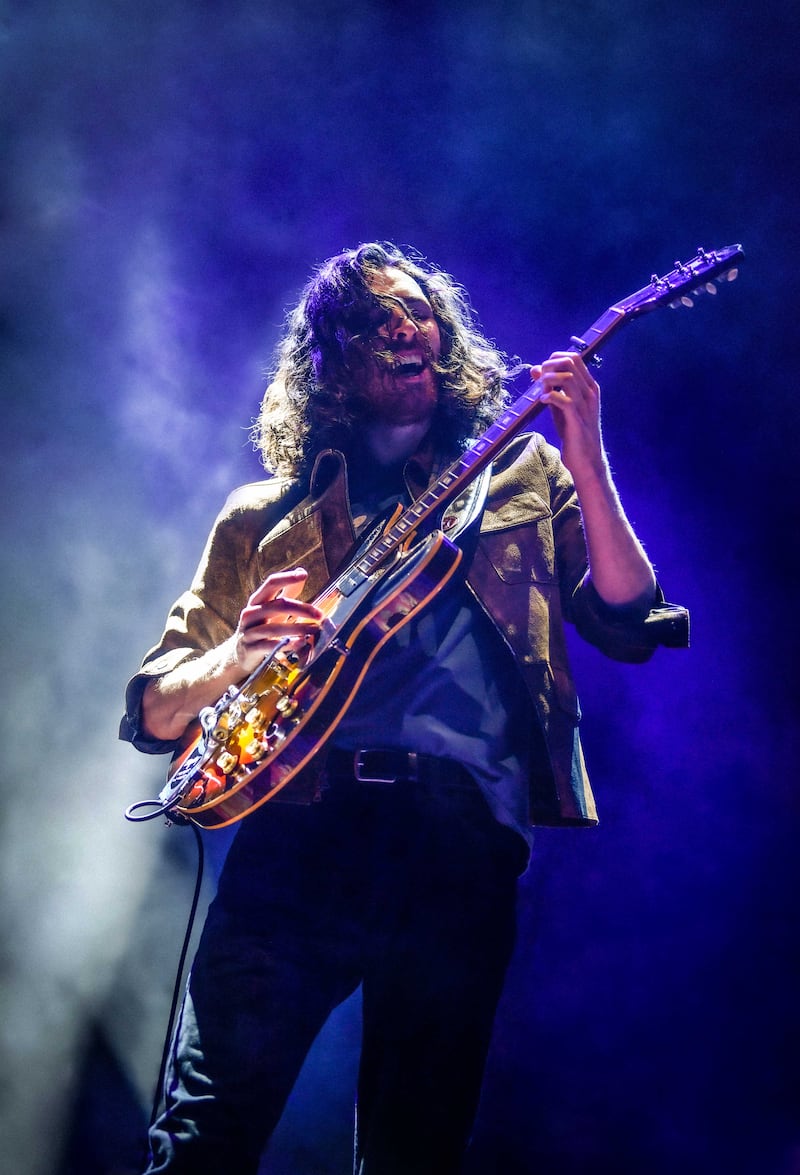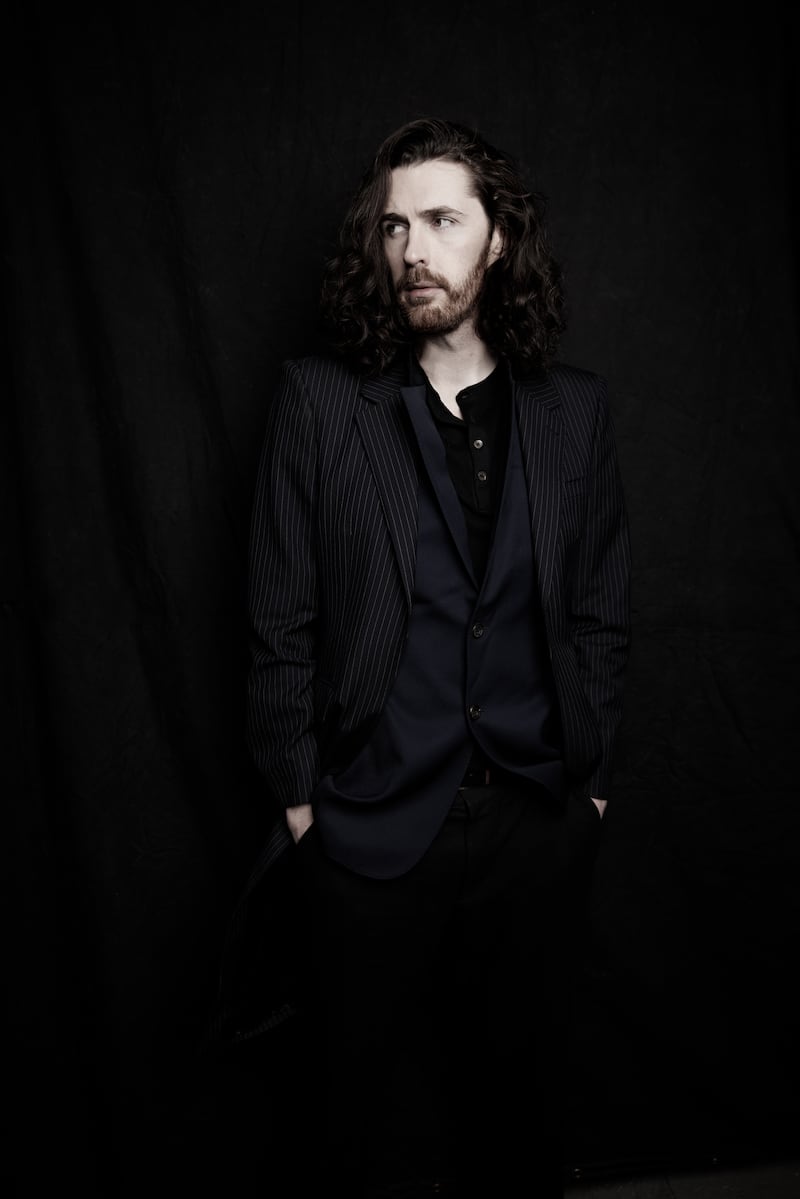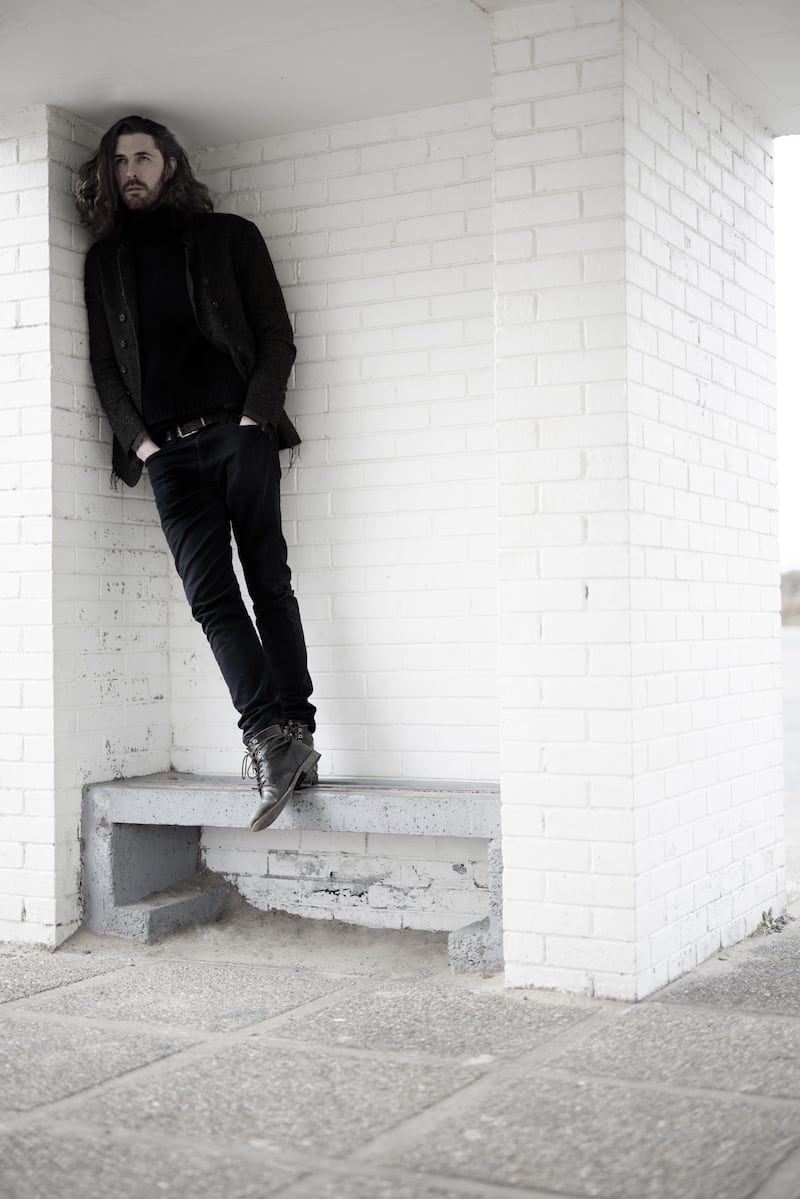In early April of this year, Andrew Hozier-Byrne was at Middle Abbey Street in Dublin for a series of shows at the Academy that were billed as live rehearsals. The polished set felt far more elevated than just practice: in the room, the sound pristine, Hozier’s voice soared. The singer and his band had spent the weeks running up to the shows rehearsing in the venue’s basement: there were parts to learn from a new album, Unreal Unearth, Hozier’s third, with which the Wicklow man continues to shape his vision.
The fullness of Hozier’s work is now so identifiable that he has become a “sounds like” reference point. He is back on the road, and he excels live. Tickets flew out for performances at prestigious venues such as Red Rocks Amphitheatre, the Hollywood Bowl and Madison Square Garden. Attendees are not just heading along to hear the early hits. His concerts are filled both with fans who have followed him for the guts of 10 years and with a new wave of teenagers who are gripped by the romance and epic nature of his lyricism and are in awe of his voice and guitar-playing, picking over his songwriting, themes and aesthetic codes with the sort of enthusiasm usually reserved for elite-level nerdism.
[ Unreal Unearth, Hozier’s new album, reviewed track by trackOpens in new window ]
But this isn’t unhinged standom: it’s a genuine community of fans who appreciate him in a way that borders on wholesomeness while also fully getting the swampy darkness of his gothic inclinations. And so Hozier is niche and Hozier is utterly mainstream. Hozier is specific and Hozier is broad. Hozier is, well, Hozier. He is his own artist. At his largest ticketed headline show so far, in the grounds of Malahide Castle in June, everywhere there was friendliness, camaraderie and joy. He played the show, and he and the band were excellent. Hozier never went away, and Hozier is back.

It’s still difficult, a decade on, to appreciate the scale of the success of his breakout hit, Take Me to Church. It became a crossover giant, with, ultimately, more than two billion streams on Spotify. This puts it in the platform’s 30 most streamed tracks ever, where it jostles for space with Queen, Harry Styles, Ed Sheeran, The Weeknd, Billie Eilish, Drake and Post Malone. To attempt to bottle such lightning again would be a kind of torment. Some songs, books, films, performances are just massive. What’s fascinating is how Unreal Unearth finds a path beyond the hit, in the way that songs such as Nina Cried Power, from his second album, Wasteland, Baby!, also forged one.
READ MORE
In the creation of Unreal Unearth, Hozier had a vision. The album is informed by Dante’s Inferno, a series of concentric circles transposed to the album’s theme and flow. It began with a shedding. “The pandemic was weird,” Hozier says, sitting in his dressingroom backstage at Malahide Castle the day before that summer homecoming gig. “I emptied my pockets of a lot of ideas, probably hit the walls I was going to hit, and then started working and collaborating in a new way with producers, and just sort of letting go of the reins and letting producers produce.”
Those producers include Hozier himself, Bekon (Danny Tannenbaum), Jennifer Decilveo and Jeff “Gitty” Gitelman. Tannenbaum is best known for his work on Kendrick Lamar’s Grammy- and Pulitzer-winning album, Damn. He also worked on Lamar’s follow-up, Mr Morale & the Big Steppers, and with Baby Keem, HER and SZA. Gitelman has worked with The Weeknd, HER and Mac Miller. Decilveo has written for and worked with Miley Cyrus, Lucius and Beth Ditto, among others. A key contribution of Decilveo’s on Unreal Unearth is cowriting and coproducing the fantastic Francesca.
While a lengthy list of personnel can lead to album-making by committee, Unreal Unearth lands as a true, and surprising, reflection of Hozier’s vision. The deeper you go into it, the more there is to discover. Within the record are layers of paradox in tone and feel; it’s sensual yet sometimes intentionally distant, intellectual and earthy, robust and delicate.
Hozier spent the pandemic doing “internal janitorial work as best I could in that time”, swimming and, occasionally, being tormented by crows in a rookery above his house. “I’m talking 50 crows twice a day doing Hitchcock hour,” he says. He emerged from the isolation with a newfound excitement for working with others. “I think it is a self-assured thing. It feels, as time goes on, you need not be as controlling for fear that it may not happen the way that you want it to. I think, when you’re confident, the more you gain a good relationship with what your abilities are; you’re able to pivot and change and take things on the fly as things develop.”
Hozier talks about becoming better at communicating what is and isn’t working for him, what he wants out of something, progressing beyond an old mode of “trying to do way more stuff myself”.

By his side is his musical director, Alex Ryan, who has been with him since their days at Trinity College Dublin and who was one of the first people Hozier played his own music on stage with. Ryan spends some of his time in Nashville, where he got to know some excellent musicians while finding new members for Hozier’s band. “We have a lot of shared vision as to what makes for a great band,” Hozier says. “You look at all those legendary bands, and there’s an experience of going to a show ... just seeing great musicians do what they do. We’ve a real appreciation for that.”
What’s stunning about the language is that it’s the language of a lived experience. It’s of tactile things in the natural world that you experience and you feel
— Hozier on the Irish language
Besides Dante, Hozier was dipping in and out of Ovid’s Metamorphoses. If you thought kids on TikTok wouldn’t be crazy about songs that nod to medieval and Roman epic poetry, then you’d be wrong. It seems the more Hozier digs into his love of such material, the more the resulting music connects. As Unreal Unearth evolved there were times he couldn’t settle on how often to refer to such inspirations. At one point he had to pull back, “because it was getting too musical-theatre. You make references that are too specific to the text and you’re going down a very different path.”
For an artist who writes beyond the restrictions of a single style or genre, the Inferno-influenced structure of circles provided a creative framework. In time, someone pointed out to Hozier the number of references to water on the album. What was filtering in, beyond source texts, was the amount of time he spent in saltwater during the pandemic, swimming, in nature, close to both the countryside and the Irish Sea, often alone. At some point, he says, his brain stopped coding information, and whatever was filtering in then filtered out through his songwriting.
Something else flourishing for Hozier is his relationship with the Irish language. It’s on his album at a moment when many Irish artists are exploring and including Irish-language lyrics on records that go beyond traditional music, from rock acts such as Fontaines DC to rappers such as Selló and Kneecap. “It’s something that I always wanted to explore,” Hozier says. “There’s something else that’s really happening [with the language] now. It’s that use-it-or-lose-it thing.”
On the track To Someone from a Warm Climate (Uisce Fhuaraithe) you can sense his love affair with the meaning of the Irish term in its title, the feeling of coolness only water brings. “There’s this whole layer of beauty to the language that I hadn’t allowed myself up until that point,” he says. “There’s so much that cannot be expressed outside of that language, that language can express that we’re unaware of ... What’s stunning about the language is that it’s the language of a lived experience. It’s of tactile things in the natural world that you experience and you feel.” He equates his exploration of Irish as “this toolbelt that was hanging up that I never used” – although he was, to be fair, a proficient debater through the Irish language in his school years.
Also present on the album is Brandi Carlile, guesting on Damage Gets Done. “I don’t know how Brandi keeps up with Brandi,” Hozier says. “She is kind of a magical person. She has so much energy, so much generosity of spirit. I mean, she’s obviously supremely talented. She has this incredible voice and is a staggeringly, staggeringly good songwriter and producer.”
[ Hozier: ‘If I wanted to make a f**king pop song, I would’Opens in new window ]
One day Carlile brought Hozier to Joni Mitchell’s house. It was to be the first in a series of private jams that ultimately culminated in Mitchell playing live in public again. Carlile “said to me early on, ‘I just want to get musicians around, and play music around Joni, so that she feels safe enough that, if nothing else, she feels comfortable and safe around that,’” he explains.
“She put this wonderful community around Joni Mitchell. And there’s very few people who could show such leadership in that. Brandi Carlile created something incredible in what she called the Joni Jams, getting together and jamming in that house, and creating this really supportive, very loving community, letting Joni know just how much she was adored and really worshipped by musicians. I like to think that I’m quite a warm person, but there’s courage in the type of warmth that Brandi has. There’s courage in the kind of leadership she has. She’s incredible.”

Hozier describes Mitchell as a “minor god figure for a lot of people. She’s kind of like our living Orpheus.”
How could an artist not be inspired by such experiences? The direct, visceral emotion Hozier channelled in his earlier work has evolved into something more complex. The track Son of Nyx, for example, came about as a collaboration with Ryan, after the death of Ryan’s father, Nick. Ryan sent Hozier a piano piece as a phone memo. When Hozier heard it he imagined it on the album. The title plays on Ryan’s father’s name and on Nyx, a god of night.
When the producer Dan Tannenbaum, who is also a classically trained violinist and pianist, heard Ryan’s phone memo he began composing “these really lush arrangements just on the fly, never putting pen to paper”, Hozier says. The strings were ultimately recorded by a Hungarian orchestra, in Budapest. The song is all at once a tribute to a father, a son, legend and myth, and a complicated exercise in composition and recording.
When I want a holiday, I go over the road as far as the meadow. I go in there, take off my jacket, and lay down on it. I watch the world turning for a bit, with me still in it. That’s happiness
— Hozier
“When you’re doing string sessions the hardest thing is always time,” he says. “It’s always for the last little things, like ‘That note – can you just hold it that bit longer?’ You’re constantly trying to tell yourself: chill out, you can’t be greedy. You could break everyone’s heart and melt everyone’s brain by being, ‘Okay, yeah, at bar 12, just give it a bit of a pause.’ You’re constantly trying to figure out what can be done in post[-production]. But I am present. This album was actually more not trying to be the control freak.”
At a time when the streaming model appears to favour excessively simple songs, Hozier is journeying towards a musical maturity, both as a live musician and as a composer, writer and lyricist, that leads to songs that are simultaneously profound and capable of being streaming powerhouses. But complexity and simplicity can live alongside each other, of course – simplicity is complexity resolved, as the modernist sculptor Constantin Brancusi put it.
In conversation, Hozier displays the kind of calm understanding and assured knowledge that speak of complexity resolved: he’s very good at what he does, he knows the things that matter, and he’s going for it. As he sits drinking tea at Malahide Castle, polite, gentle, open and confident, he talks enthusiastically about This Is Happiness, the novel by Niall Williams – “a beautiful writer, an excellent writer”. Williams, who lives in Co Clare, has told the story of a conversation he had with an octogenarian farmer, Michael Dooley, who worked on the land all day and never complained. One day Williams asked Dooley if he ever took a holiday. “A holiday?” Dooley responded. “I mean,” Williams said, “what do you do to be happy?” Dooley considered the question before eventually saying, “When I want a holiday, I go over the road as far as the meadow. I go in there, take off my jacket, and lay down on it. I watch the world turning for a bit, with me still in it. That’s happiness.”
As Hozier’s world turns at an intimidating pace, there’s a sense of groundedness about him, of watching that world turn, jacket off, in some mind’s-eye meadow, lying in some unreal unearth.
Unreal Unearth is on Rubyworks/Island Records





















